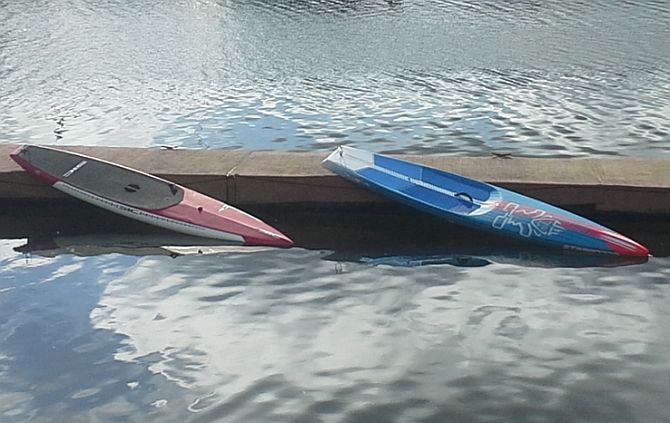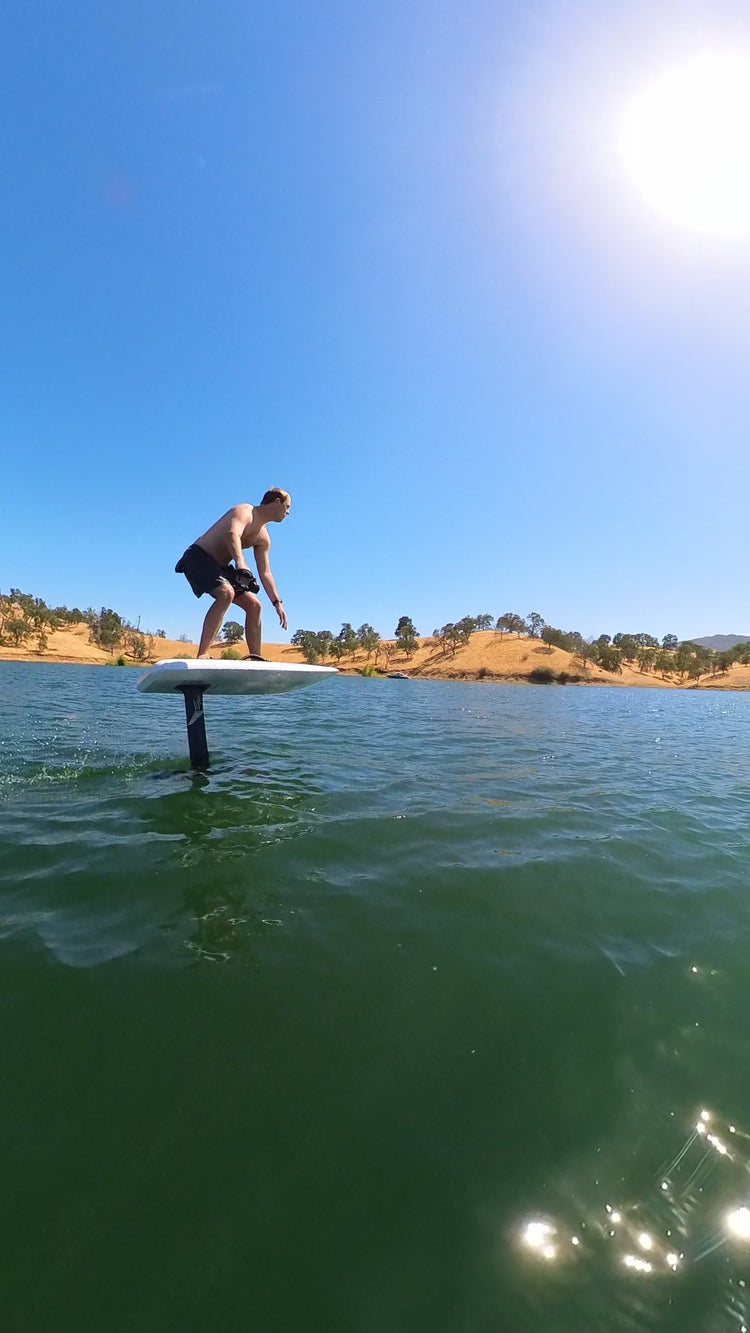

Well first off we have to say this is one of the most fun tests we have run and featured two of the most versatile racing stand up paddleboards on the market.(pictured at left the 2016 SIC FX and at right the 2016 Starboard All Star)
When speed is of the essence, designs that sacrifice too much to obtain it can be fickle and finicky. Frankly, not too much fun to ride either. We can say with unabashed glee that these two beauties are both fast and fun. Certainly neither of the two boards is going to be the fastest board on the water when the conditions are mirror like. Since that practically never happens when paddleboarding on San Francisco Bay, you are sure to see these two on top of a podium near you soon.
The day of our test was a windy, blustery, rainy day. With winds 10-20 mph, and wave chop in the 1-2 foot range on the bigger ramps, it was the perfect set up for testing these all water machines. To get to the bumps we first have a mile of flat water to cover making for the perfect test of performance in the contrasting conditions. Our test was performed by two riders pacing each other while switching boards in the various conditions.
Our two test boards
- 2016 Starboard All Star 12’6 x 25 Full Carbon – 22.5lbs weighed with fin and rail tape. (11.1lbs liter) $3499
- 2016 SIC FX 12’6 x 26 SCC Full Carbon – 24lbs weighed with fin and rail tape (10lbs/ltr) $2699
The Flats – We have to give the nod to the SIC. A couple of variables make this board a bit better of a flat water racer, and first up is the lower volume, more aggressively pulled in nose. The cleaner entry of the SIC is simply displacing less water. In addition the SIC is noticeably stiffer. The straighter less shaped rails aid in a bit better tracking, and make the board super stiff. The SIC is more sensitive to rail steering but far more forgiving than found on most any other race board. The margin however was very tight with the SIC barely edging the Starboard in drag racing conditions. We were a bit surprised by this finding as the SIC “looks faster” on the beach and “feels faster” when paddling it.
Upwind in the bumps – This wasn’t really a contest with the All Star simply dominating. The more flexible layup simply shined. Bumps were absorbed with much more efficiency and leg pumping was rewarded with upwind squirts reminiscent of pumping a skateboard ramp. The Starboard dropped the SIC with relative ease. The 2016 All Star may be the best upwind board we have ever paddled.
The Cross Chop – This one was sort of a draw and that too was a bit of a surprise. We expected the SIC’s lower volume nose to outperform the Starboard for two reasons. Less swing weight and less surface area for both wind and wave to push around. However the Starboard seemed a bit easier to keep on line. The softer rails absorbed the energy better than the flatter SIC rails. In addition the more curved outline responded better to being rail steered upwind. Lastly the lower rider height on the Starboard makes the rider feel a bit more stable than the higher riding SIC. With that all said the SIC was the faster board. We suspect paddling longer distances in the cross chop would further help the SIC better gap the Starboard. Lower noseweight is simply less work for the paddler in these conditions. We should add that these boards are amongst the best we have ever ridden in dealing with what is the toughest point of paddle.
Downwind – Yeeeehawww! After paddling for 30 minutes straight up in to a 20mph storm wind it was fun sleigh riding home. Both boards were in their element with nice rollers, pushing some nice glides that set us up for some nice connecting opportunities. The best way to describe the Starboard All Star is fast, but more importantly easy to ride. The rider was given ample time to move their feet as the bumps would drop the nose while raising the tail. The extra nose volume in the Starboard, along with the softer entry meant that mistakes simply had no consequences. Wave steering and course correction was quick and easy on the Starboard. In some instances a wave the Starboard could handle with no foot movement required a twostep shuffle on the SIC. The more flexible lay up once again showed itself as a distinct benefit. Quick paddle sprints, timed with board pumping, resulted in instant acceleration without any push off line. The SIC on the other hand required much more attention.That extra attention was however rewarded with top end berst the All Star wasn't hitting. Riders on the SIC will need to move both feet, and move them quicker, in order to coax this extra speed from the board. As conditions get bigger we think this will further tilt the favor towards the All Star while the SIC will be faster in the smaller bumps. While a more seasoned rider may get slightly faster times on the FX we suspect that most paddlers will be much faster on the forgiving All Star. Higher level riders however will go faster on the SIC.
Buoy Turning – Not much contest here where our suspicions were confirmed with the SIX FX being the better board. With swing weight such a big factor the SIC simply shined when contrasted to the front loaded Starboard. It pivoted on a dime and jumped out of the turn with playful ease. The Starboard simply lumbered around.
Stability - The Starboard is more stable despite being an inch narrower. This is even more pronounced when riding on the back of the board – see buoy turning above. The unique transom and bottom design of the board are the real deal. The higher rider height and flatter bottom make the SIC FX board a bit tipsier in both initial and secondary stability.
Fun Factor – Most of the time we discourage recreational paddlers from buying all out race boards but these two boards both break the rule. With such wide functional profiles, and forgiving characteristics, both of these boards are fun defined. With that said we’d tilt our hat to the Starboard in this department. We can see this board redefining what a fun downwind board looks like while still paddling superfast in a variety of conditions.
Construction – The Starboard is a better built board. While both boards are constructed better than your average race board, Starboards PVC Sandwich construction is simply industry leading. You have a lightweight board that is actually durable as well. The control over flex leads to game changing performance in rough waters. We can’t stress enough the durability of these boards when contrasted with most lightweight racing products and their egg shell exteriors. We actively rent these Starboard Carbon Race Boards and are blown away by their resiliency. Both boards are manufactured at Cobra, in Thailand, which has proven itself superior to any of the Chinese factories. If you’re hard on gear, or you want to maximize resale value, the Starboards (and other Cobra built boards) the higher prices may be money well spent.
Price – The SIC is a much less expensive board, but whether it’s a better value or not is the real question. If the extra $800 dollars is a tipping point well then your decision just got easier as that is a lot of dough. From a value perspective we've gotta hand it to SIC this is a great board for the money.
Fins - Both test boards were tested with the same fin. With that said however the Starboard comes with a much better fin. The FX fin really should be upgraded upon purchasing the board with the stock fin better suited to the SIC X line of boards.
Ok so you read all that and still don’t know which one is better. Well the answer is easy – it depends. If you find yourself most often paddling in flatter waters and, racing is your priority, with that rough water option in hand; Take the SIC - the board will win races with textured waters. If, however, you want a rough water rumbler that can still take down the flat water prize, while giving you a downwind racing platform, the answer is the 2016 Starboard All Star.

